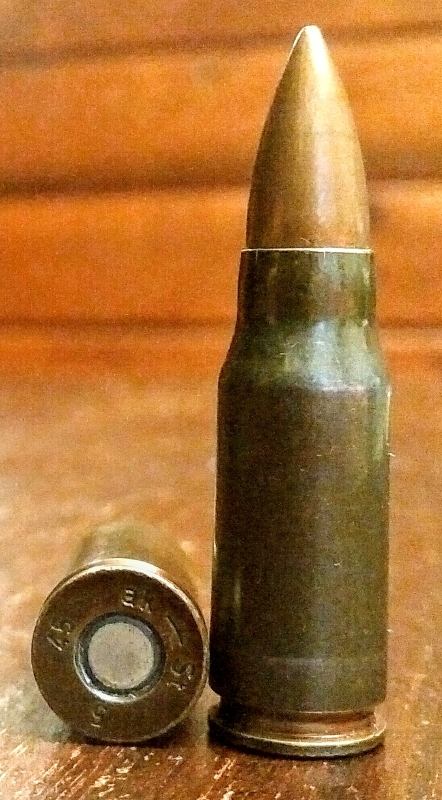Germany worked hard to develop new weapons as an innovator of cutting-edge weapons in WWII. In 1942, they began working on their first Assault Rifle (The Sturmgewehr, or Assault Rifle). The STG 44 was intended to replace both the MP-40 9mm submachine gun as well as the Gewehr 98 bolt action rifle, which was the mainstay of the German military since WWI.

STG 44 | Necessity Is The Mother Of Invention
The 7.92 (8mm Mauser) round was good for reaching out long distances, but the Germans were figuring out that most infantry engagements were taking place within 300 meters. Hence, they began concentrating on a bullet that would address these distances and yet have a similar level of firepower that their submachine guns had for close work.

A New Bullet
In 1938, a contract was issued to develop a cartridge specifically to fill these requirements. Specifically, it was the 7.92×33 Infanterie Kurz Patrone, or “Short Cartridge.” This was an intermediate round, falling between the 7.92 Mauser round used in the Mauser 98K and the 9x19mm round used in submachine guns. The intermediate round was not as deadly as the 7.92 Mauser round, but it was capable of fully automatic fire, which made it valuable to the Germans.

Innovation
Delays
Hugo Schmeisser, Haenel’s Chief Designer, came up with a design utilizing a barrel and stock in a straight line, which reduced muzzle rise by causing recoil to travel back in a straight line. In addition, the design utilized a pistol grip and V-sights. The new Assault Rifle was gas operated and made from metal except for the wooden buttstock. It was made mainly from stampings, which simplified production and made it less expensive to produce. That was a huge factor in late wartime Germany, given their waning resources. Natural resources were hard to access, and the allied bombing of German factories decimated their ability to produce weapons and other essentials.

Tooling up for production was time-consuming, and production was not ready to begin until 1942. In the meantime, other German weapons producers were entering the fray with designs on their own, adding to the competition.
Fuhrer’s Disapproval of the STG 44
When Hitler learned of the project, he favored scrapping the entire premise because Germany had already produced millions of 8mm Mauser rounds. He saw the Sturmgewehr as a waste of resources. To counter this, the Stg was renamed a “Machine Pistol,” and production moved forward as the MP-43 to hide the assault rifle from Hitler.
Eventually, Hitler learned the truth, but by then, the reports he received of the MP-43 from the front lines were so positive that he decided to allow the production to proceed.

The Stg-44 could make use of even more stamped parts than the MP-43, simplifying its production. It is rumored that Hitler coined the phrase Sturmgewehr (Assault Rifle).

The Stg-44, which it was eventually named, could take fairly accurate shots out to about 200 yards and provide real close-in full auto fire. Because it could easily be field stripped into six parts, it was popular with the troops.

Weighing just over 11 pounds with a full 30-round magazine in place, it was not a lightweight weapon. But, coming in at 37 inches with a 16.5-inch barrel, it was somewhat compact compared to the long bolt action infantry rifles that the Germans regularly issued.
The entire auto fire was controllable, given the weapon’s heavyweight and slow cyclic rate of 500 rounds per minute. In addition, the muzzle velocity of the rounds was 2,250 feet per second.
A Compromise
It was a sort of “compromise” weapon, not as effective or deadly at long range as a rifle, only able to engage at shorter ranges. But the full auto capability was something that the Germans required. Moreover, they realized it was necessary after facing the Soviet hordes, especially in urban combat in cities like Stalingrad.

Too Little, Too Late
In total, 425,977 Assault Rifles were produced by Germany during WWII, but it was not enough to stem the allied advance. As was the case with many German weapons, they were excellent, but it was too little, too late. The introduction of this innovative weapon was shortly before the end of the war.

The STG 44 Legacy
Despite that, as with many other German weapons from that era, we still see their influence on firearms even today. For example, the straight line stock concept is here to stay, among others.
These days, authentic specimens are rare, and ammunition to fire through them is also scarce and quite expensive.

If they don’t already know, most people correctly guess that the STG 44 is the grandfather of the Soviet AK-47, sharing many similarities. The Russians respected the capabilities of the Stg-44 enough to realize that they’d be foolish to pass up copying some of its traits. So in that way, the Stg-44 lives on in the AK-47 design. Even the American M-16/M-4 family of weapons uses a straight-line stock, a concept pioneered by the Germans in WWII.
The bottom line is that the Stg-44 (among other German weapons) was a serious game-changer, the effects of which we’re still seeing today.


